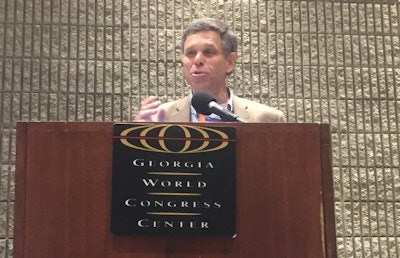
Broiler production has come a long way over the last 50 years in terms of improving bird performance and minimizing the environmental impact of production. A new model being developed for the poultry industry aims to help producers estimate their environmental footprint in order to further enhance the sustainability of poultry production. Dr. Greg Thoma and Martin Christie, University of Arkansas, spoke about these industry improvements and previewed this new broiler production model during the Animal Ag Sustainability Summit at the 2018 International Production and Processing Expo (IPPE).
A comparative lifecycle assessment of U.S. broiler production for the years 1965 and 2010 shows the industry’s improvement and how much sustainability metrics have improved over time.
Thoma pointed to several industry improvements from 1965 to 2010:
- Production length shortened from 66 days to 47 days
- Market weight increased from 1.6 kg to 2.59 kg
- Feed conversion improved from 2.44 kg feed/kg LW to 1.94 kg feed/kg LW
- Mortality reduced from 6 percent to 4 percent
“We’ve come a long way, baby,” he said.
Thoma said the industry’s greatest relative improvement is in the noncarcinogenic impact associated with particulate matter, while the least improvement has been in eutrophication.
“We eat a lot more chicken than we did in 1960, which is a good thing for the industry. It comes with some impacts but those impacts are significantly smaller than they might have been otherwise without the tremendous improvements over time that we’ve seen,” said Thoma.
“We need to understand at a more granular level what’s really going on,” he said, adding that this is one of the driving factors for developing the new poultry calculator.
How the Poultry Calculator works
Thoma and Christie explained how this new poultry calculator will work to help the industry measure and reduce its impact on the environment.
This browser-based interface allows the farmer to input the specific data about their farm, such as facility information, weather data for the farm’s county, broiler breeds, starting weights and target finishing weights, and more. The formula then calculates bird performance under the specific barn conditions and also allows for “what if” scenarios, giving producers and integrators a useful tool to assess their own operations and where the greatest need is to reduce their environmental footprint.

Martin Christie | Photo by Alyssa Conway
The calculator is set with three different simulation submodels:
- Barn: This submodel simulates the operations in different types of barns and allows the user to keep track of the resources used in each facility to maintain the optimal growth environment.
- Broiler: This submodel simulates different broiler strains, allowing the user to track the feed and water required for broilers to reach their genetic potential.
- Environmental impacts: This submodel simulates the farm’s global warming potential, water depletion and land occupation.
The calculator’s outputs include: broiler performance, feed conversion ratio, average daily gain, total feed intake per bird and per year, ingredient breakdown, litter and composition of gasses, mortality, resource consumption and environmental impacts.

















